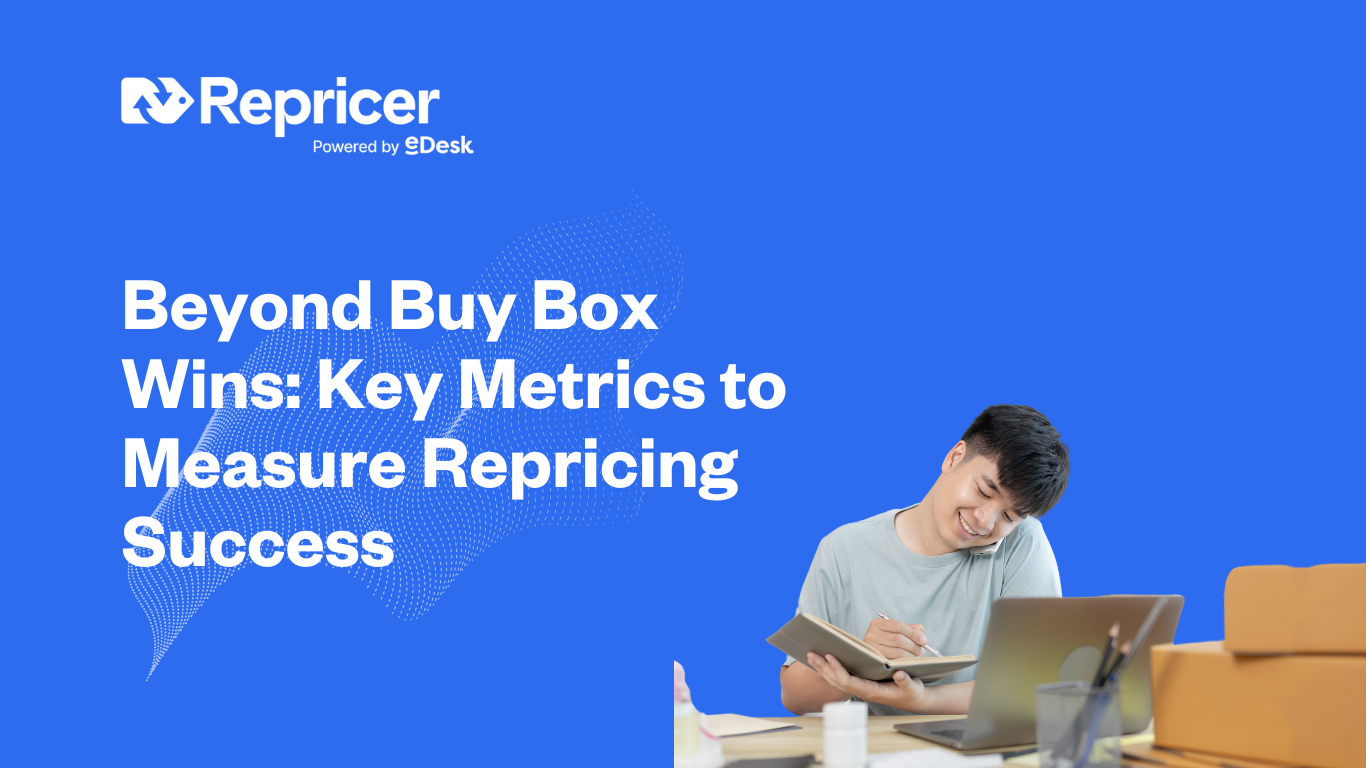If you’re one of the 75% of Amazon sellers using repricing software to compete for the Buy Box, you’ve probably focused heavily on that all-important Buy Box win percentage. After all, over 83% of Amazon’s conversions occur using the Buy Box, making it seem like the ultimate success metric.
But here’s the thing: winning the Buy Box doesn’t automatically guarantee profitability or long-term success. Smart sellers know that to truly measure repricing success metrics, you need to look beyond that single number and dive deep into the data that tells the complete story of your repricing performance.
Why Buy Box Percentage Isn’t Enough
While Buy Box percentage remains important, it’s just one piece of a much larger puzzle. You could be winning the Buy Box 90% of the time, but still losing money if your prices are too low or missing out on higher profits if you’re underpricing products with strong seller metrics.
The most successful Amazon sellers understand that effective repricing is about finding the sweet spot between competitiveness and profitability. That’s where comprehensive repricing analytics come into play.
Essential Amazon Repricing KPIs to Track
Average Selling Price (ASP) Trends
Your Average Selling Price tells you whether your repricing strategy is driving prices up or down over time. Monitor ASP changes across different time periods to understand:
- Whether seasonal trends are affecting your pricing
- If competitive pressure is forcing prices down
- Whether your repricing rules are maintaining healthy price levels
Track ASP by product category, individual SKUs, and overall portfolio to identify which products might need rule adjustments.
Profit Margin Per SKU
This metric is crucial for understanding the real impact of your repricing decisions. While winning the Buy Box at $15 might feel good, it’s not helpful if your break-even price is $16.
Monitor profit margins to ensure your repricing strategy maintains profitability while staying competitive. Look for:
- SKUs where margins are consistently declining
- Products where you can afford to raise prices slightly
- Items where current margins support more aggressive pricing
Sales Velocity Changes
Sales velocity measures how quickly your products are selling and directly correlates with repricing effectiveness. When you optimize pricing correctly, you should see improvements in:
- Units sold per day
- Time to sell through inventory
- Revenue per period
Compare sales velocity before and after implementing repricing rules to quantify the impact of your strategy.
Price Adjustment Frequency
How often your repricing tool makes changes can indicate market competitiveness and rule effectiveness. Track:
- Average number of price changes per SKU per day
- Time between adjustments
- Correlation between adjustment frequency and sales performance
High-frequency adjustments might indicate overly aggressive rules or highly competitive markets, while infrequent changes could suggest opportunities to be more responsive.
Where to Find These Metrics in Your Repricing Platform
Most modern repricing platforms, including Repricer’s Analytics & Reporting tools, provide comprehensive dashboards where you can access these metrics. Look for:
Performance Dashboards: Real-time views of Buy Box wins, price changes, and sales performance
Historical Reports: Trend analysis showing how metrics change over time
SKU-Level Analytics: Detailed breakdowns for individual products
Profit Analysis Tools: Calculations that factor in all costs to show true profitability
The Insights section typically offers deeper analysis, helping you understand not just what’s happening, but why it’s happening.
How to Interpret and Act on Your Data
Identify Patterns and Trends
Look for recurring patterns in your data:
- Do certain products consistently underperform?
- Are there seasonal trends affecting specific categories?
- Which time periods show the best profit margins?
Set Performance Benchmarks
Establish baseline metrics for:
- Minimum acceptable profit margins
- Target Buy Box win percentages by product category
- Expected sales velocity improvements
Create Action Plans
Use your data to make informed decisions:
- Adjust pricing rules for underperforming SKUs
- Allocate more inventory to high-velocity products
- Modify competitive positioning based on margin analysis
Advanced Metrics for Data-Driven Sellers
ROI on Repricing Software
Don’t forget to track the return on investment of your repricing tool itself. Calculate the ROI of your repricing software by comparing increased revenue and time savings against the subscription cost.
Competitor Price Tracking
Monitor how your competitors’ pricing strategies affect your performance:
- How often competitors change prices
- Price gaps between you and key competitors
- Market share shifts based on pricing moves
Rule Performance Analysis
Evaluate which repricing rules work best:
- Rules that maintain the highest profit margins
- Strategies that drive the most sales volume
- Configurations that balance both metrics effectively
Building Your Repricing Analytics Report
Create a regular reporting schedule that includes:
Daily Monitoring: Buy Box wins, major price changes, inventory alerts
Weekly Reviews: ASP trends, profit margin analysis, sales velocity changes
Monthly Deep Dives: Comprehensive performance analysis, rule effectiveness, competitive positioning
Quarterly Strategy Sessions: Long-term trend analysis, rule optimization, goal reassessment
The Bottom Line
Measuring repricing success goes far beyond tracking Buy Box percentage. The most profitable sellers use comprehensive analytics to understand the full impact of their pricing strategies on revenue, profitability, and market position.
By monitoring metrics like Average Selling Price, profit margins per SKU, sales velocity, and price adjustment frequency, you can optimize your repricing approach for maximum profitability. Remember, the goal isn’t just to win the Buy Box—it’s to win it profitably while building a sustainable, data-driven pricing strategy.
Ready to dive deeper into your repricing performance? Explore the full range of Repricer Features and start using these advanced metrics to transform your Amazon business. When you can measure repricing success accurately, you can optimize it effectively – and that’s where real growth happens.





